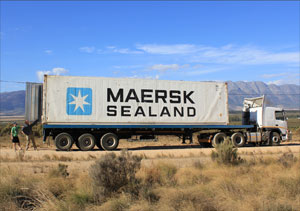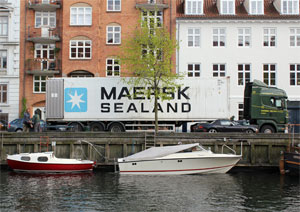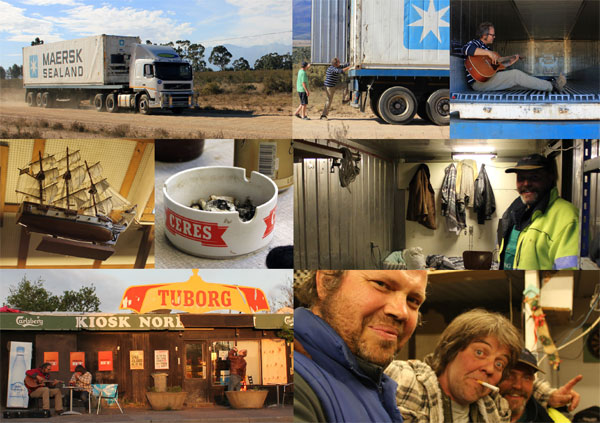

Free trade Rider
Photo and video documentation, South Africa and Denmark
2010
A couple of years ago I settled with my family in a small rural village called Riebeek Kasteel, near Cape Town, South Africa. The village lies in an important food-producing area of the country called the Swartland (Black Land) and from our house we enjoy sweeping views of wheat fields, vineyards and olive groves. Nearby runs the R45, the main road linking us to the city and harbour, eighty kilometers south. Daily, I see freight trucks carrying Maersk containers out of the valley along this route and I often wonder where they will end up. Talking to local farmers, I established that the cargo mainly consists of fresh grapes, citrus fruit and vegetables grown on farms in the Swartland and nearby Ceres valley and that these are headed to fresh produce markets around the globe. In my mind, the giant white capsules are the blood cells of free trade that connect our valley's farms to the world economy.
It appears that in South Africa, the earliest form of organised mercantile trade was introduced by Dutch settlers led by Jan van Riebeeck in 1652. By 1661, to supply their trade ships, the Dutch East India Company established farms and orchards in the fertile valley surrounding Riebeek-Kasteel, a day's wagon ride from the company headquarters in Cape Town, a five-pointed stone castle pictured below, left.
Following the trail of the modern Maersk wagons, I looked at Google Earth satellite imagery of Copenhagen, Denmark, where the company is based. I was more than surprised to discover the unmistakable outline of a very similar pentagram-shaped castle right next to the Maersk head office. The Kastellet, (below, right) was built in 1626 to protect Copenhagen harbour and later improved by Dutch engineer, Henrik Rüse. During the period 1989-1999, the Kastellet was restored with funds from a wealthy businessman, A.P. Møller, of the Danish freight company, A.P. Møller - Maersk.
The long and the short of it all: in late April 2010, I climbed into a Maersk container on a dusty road in the Swartland, and stepped out in Copenhagen three weeks later. In the city's trade harbour I met and befriended a Dane called Thomas Andersen, who lives in a container community with other free-spirited folk. Thomas - who displays a model ship above his door, plays harmonica and and puts his cigarettes out in a Ceres ashtray - gave me a copy of Charlie Musselwhite's blues album, Continental Drifter. By return trade, I taught him the new tune that I had composed during my conceptual journey: Free Trade Rider.
